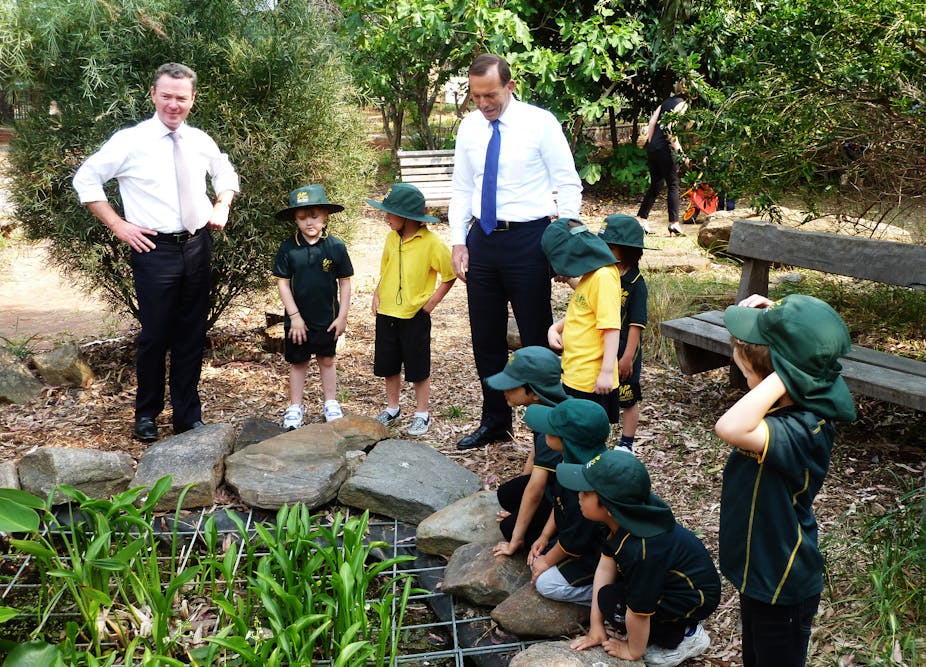For the last four decades the passe debate about paring the school curriculum “back to the basics” has continued to surface. This time it has been brought about by Education Minister Christopher Pyne on the basis that the broad and inclusive Australian curriculum is not providing students with competitive 21st-century skills.
Although arguments are compelling for both “decluttering” and “rebalancing” the curriculum and addressing the learning needs of Australia’s most disadvantaged, the call to focus on “the basics” of numeracy and literacy implies the current research-based Australian curriculum does not address numeracy and literacy skills.
This is not the case. Numeracy and literacy are rich and substantive elements, inherent across all learning areas as important capabilities.
Phonics and whole language aren’t mutually exclusive
On closer examination of the “back to basics” refrain, we can see a pointless and distracting argument around phonics and whole language practices. Pyne has advocated a focus on phonics (sounding out words) in teaching reading.
A balanced and integrated approach to literacy of course incorporates phonics. But not all words can be sounded out and students need a range of strategies to tackle our complex language. For learning to be most effective, it targets the learners’ needs and shows students how it is relevant.
With a few exceptions, rote learning can be likened to memorising the phonebook – that is, rather pointless with little meaning. An over-reliance on “drill and kill” teaching is arcane and redolent of the industrial age.
The learners of the 21st century are required to read and write and interact with knowledge through critiquing, manipulating, creating and transforming it. Higher-order skills such as critical and creative thinking, as prerequisites for the knowledge age, are inherent in numeracy and literacy.

With exponential social, economic and technological changes taking place in the world, we want our youth equipped with the skills (basic and sophisticated) and the capabilities to solve problems and meet new challenges.
We want them to apply, construct and reconstruct knowledge in new ways. This form of complex knowledge transfer is not addressed through a curriculum that focuses exclusively on low-level skill acquisition, gained primarily through transmission teaching. This is a teacher-centred orientation that imparts information without consideration of student meaning-making processes.
What are we losing in paring back the curriculum?
It seems paradoxical to suggest that we can “add more depth and less breadth” to a “robust, balanced and relevant” curriculum by integrating key learning areas.
We are losing critical engagement with who we are, where we are from and where we are going, when we collapse history, geography, civics and citizenship and economics and business into a single combined humanities and social sciences subject for primary schools as has been recommended.
It is likely that this reductive move could exacerbate a widening gap between private and state education. Over 30 years ago, groundbreaking research by education policy professor Jean Anyon determined that students from higher socioeconomic backgrounds were more likely to be exposed to legal, medical or managerial knowledge than the “working classes”.
The “working classes” were offered a functional and practical curriculum that targeted clerical knowledge and vocational training. In the “working class” schools of Anyon’s study, knowledge was seen as a set of procedures handed down to students by some authority. In contrast, students in the affluent schools conceived of knowledge as something that they could create through their critical thinking.
More recently, in support of Anyon’s work, researcher Alan Luke cautions that the key policies of scripted, standardised teaching risks offering working class and cultural and linguistic minority students precisely what Anyon described: a curriculum of basic skills, rule recognition and compliance.
This conception of what is “basic” falls significantly short of the “robust” and “relevant” curriculum Pyne said we require for 21st-century learners.
The “basic” curriculum, with its reduced focus on narrow conceptions of literacy and numeracy, is at the expense of a broad and rich Australian curriculum. Education is a social good, a mechanism for social justice and a vehicle for social mobility.
We run a significant risk that the divide between the haves and have-nots will widen even further through the “back to basics” approach advocated. The private sector will offer an enriched curriculum whereas the public sector will provide a second-tier “basic” focus.
It is questionable whether a “dumbed down” curriculum of this ilk can offer the complexity required to address Australia’s needs as we progress in the 21st century.

